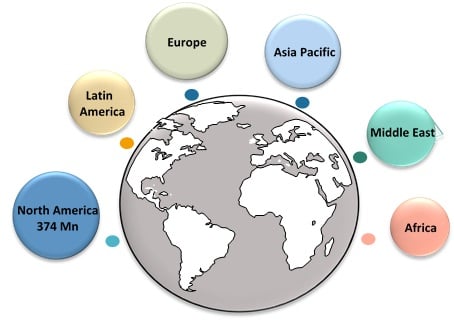
Global Cetirizine Hydrochloride Market – Offering Potential Allergic Treatment
Cetirizine hydrochloride belongs to the antihistamine drug class, which reduces the natural chemical, histamine in the body. Histamine induces symptoms such as sneezing, watery eyes, and runny nose. Cetirizine hydrochloride is used for treating cold, allergy symptoms, itching and swelling caused by hives. It is available on prescription, however, it is also available over-the-counter in pharmacies and supermarkets.
The global cetirizine hydrochloride market size was valued at US$ 1,100 million in 2017, and is expected to exhibit a robust CAGR of 3.2% over the forecast period (2018 – 2026).
The global cetirizine hydrochloride market is expected to be driven by increasing incidence of allergic conditions including allergic rhinitis, allergic conjunctivitis, and eczema.
Figure 1. Global Cetirizine Hydrochloride Market Value (US$ Mn), by Region, 2017

To learn more about this report, Download Free Sample
Source: Coherent Market Insights Analysis (2018)
Increasing incidence of allergic rhinitis to drive growth of the market
High prevalence of allergic conditions such as allergic rhinitis, also known as hay fever is expected to propel growth of the cetirizine hydrochloride market. According to the American Academy of Allergy Asthma and Immunology, 2015, allergic rhinitis affects around 10% to 30 % of the population worldwide. Moreover, according to the International Study of Asthma and Allergies in Childhood (ISAAC), 2016, the prevalence of pollen allergy or hay fever in children between the age group is 12-14 was 22.1% worldwide, registering the highest rate of 33.3% in North America.
North America holds a dominant position in the global cetirizine hydrochloride market, owing to the high prevalence of hay fever and allergic conjunctivitis in the U.S. According to the American Academy of Allergy Asthma and Immunology, around 7.8% of population in the age group above 18 in the U.S. suffer from hay fever. The National Health Interview survey, 2016, further stated that around 6.5% or 16.0 million adults and 7.5% or 5.5 million children under age 18 were diagnosed with hay fever in 2015.
Moreover, the cetirizine hydrochloride market in North America is expected to witness significant growth, owing to the increasing economic burden caused due to allergic diseases on the affected population. According to the American College of Allergy, Asthma and Immunology, 2018, allergies are the sixth leading cause of chronic illness in the U.S., with over 50 million people suffering from allergies annually, which account for an expenditure of US$ 18 billion.
However, the drug can induce severe to moderate side effects, which include insomnia, hyperactivity, uneven heartbeat, nausea, constipation, and headache, thereby limiting the adoption of the drug and hindering the market growth.
Figure 2. Global Cetirizine Hydrochloride Market Share (%), by Dosage Form, 2018 and 2026

To learn more about this report, Download Free Sample
Source: Coherent Market Insights Analysis (2018)
Increasing incidence of allergic eye symptoms and eczema is expected to bolster the market growth
Increased risks of developing allergic eye conditions with the onset of allergic rhinitis or hay fever is also a major factor driving the market growth. For instance, according to the survey conducted by Virtual Medical Center, around 97% of children diagnosed with allergic rhinitis or hay fever also have allergic eye symptoms. Moreover, the survey stated that around 56% children with asthma experience allergic eye symptoms, whereas 33% of children with eczema have allergic eye symptoms. The signs and symptoms include eye redness, excessive watering, itchy burning eyes, discharge, blurred vision and increased sensitivity to light. Furthermore, according to the study published in Clinical Review and Education Journal, 2013, around 40% of population worldwide suffered from allergic conjunctivitis.
According to the Nutrition and Health Department, 2015, atopic dermatitis (AD), also known as atopic eczema, is a common chronic inflammatory skin disease affecting 15-20% of children and 1-3% of adults worldwide. Thus, the increasing prevalence of allergic conjunctivitis and eczema is a major factor driving the market growth.
Key players in the market are focused on new product launch to enhance the market share. For instance, in 2014, McNeil Consumer Healthcare—a Johnson and Johnson Company— launched a convenient oral, dissolvable tablet to the Zyrtec portfolio of allergy-relief products. The tablets will be available for adults and children across major retailers and pharmacies.
Major players operating in the global cetirizine hydrochloride market include, Johnson and Johnson, Mylan, Inc., Nicox S.A., Strides Shasun, Apotex, Inc., Teva UK Limited, Aurobindo Pharma Limited, Jubilant Life Sciences, Tris Pharma, Inc., and Cipla Ltd.
Share
Share
Missing comfort of reading report in your local language? Find your preferred language :
Transform your Strategy with Exclusive Trending Reports :
Frequently Asked Questions
Select a License Type
Joining thousands of companies around the world committed to making the Excellent Business Solutions.
View All Our Clients